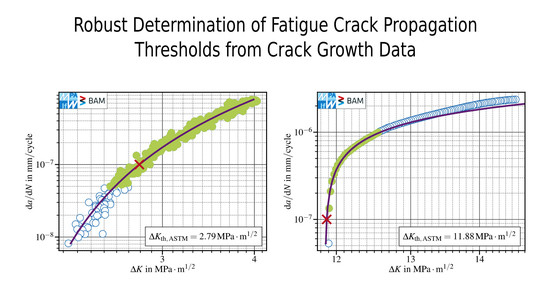Robust Determination of Fatigue Crack Propagation Thresholds from Crack Growth Data
Abstract
:1. Procedures for the Determination of the Fatigue Crack Propagation Threshold from Crack Propagation Data
1.1. Procedure Suggested by Both ASTM and ISO Standards
1.2. Procedures Suggested in the Literature
2. Experimental Procedure
2.1. Investigated Fitting Functions
2.2. Quantitative Data Analysis
3. Results and Discussion
3.1. Application to Data Obtained at
3.1.1. Evaluation for the Intervals Suggested by the Standards
Conventional K-Decreasing at ()
Load Shedding at Constant ()
Compression Precracking Load Reduction (CPLR) at
Constant Force Range (-Constant) at
Summary
3.1.2. Robustness of the Fitting Methods in Handling Data Subjected to Augmented Artificial Scatter
3.1.3. Influence of an Augmented Fit Interval
3.1.4. Data Extrapolation
3.1.5. Application to the Full Dataset
3.2. Definition of the Fitting Function and Interval for the Determination of Thresholds Obtained at
3.3. Evaluation of the Fatigue Crack Propagation Threshold at
3.3.1. Handling of Data Affected by Extrinsic Mechanisms
3.3.2. Influence of a Lower Data Density
3.3.3. Validation of the Proposed Method
Conventional K-Decreasing at in Lab Air
Compression Precracking Load Reduction at in Lab Air
3.4. Definition of the Fitting Function and Interval for Tests Conducted at
3.5. Application of the Fitting Methods to the IBESS Dataset
4. Conclusions
- The ASTM E647 and ISO 12108 standards suggest to fit over data using a linear fit, but leave plenty of room for interpretation with respect to the choice of the points in the fitting interval;
- When using all data points within the suggested fitting intervals, the most conservative values of are obtained. However, the fit is not very subjected to scattered data;
- To use only the first n data points starting from the threshold crack propagation rate in order to ensure the best linear fit reduces the conservativeness at the cost of a more pronounced susceptibility to scatter and lower density of the data;
- The proposed fitting polynomials provided an improvement with respect to the goodness of the fit and susceptibility to scatter;
- An extrapolation of data was possible within given bounds for the structural steel S690QL, tested in lab air at room temperature at . Further tests comprising changes in materials, temperatures and the test environment should be conducted to assess the validity ranges;
- Tests subjected to crack closure phenomenon cannot be assessed in a fully automatic manner and require a manual dataset evaluation.
Author Contributions
Funding
Institutional Review Board Statement
Informed Consent Statement
Data Availability Statement
Acknowledgments
Conflicts of Interest
Symbols and Abbreviations
| applied force range | |
| applied stress intensity factor range | |
| K-decreasing FCG test procedure at constant load ratio | |
| fatigue crack propagation threshold | |
| referring to the ASTM operational definition | |
| referring to the ISO operational definition | |
| obtained for the censoring of the data set | |
| mean value of the distribution | |
| ultimate tensile strength | |
| upper yield strength | |
| a | crack size |
| A | elongation at break |
| fatigue crack propagation rate | |
| referring to an operational threshold definition | |
| ASTM operational threshold definition of | |
| ISO operational threshold definition of | |
| e | Weibull threshold parameter |
| E | Young’s modulus |
| I | degree of the polynomial |
| k | Weibull shape parameter |
| Weibull instability parameter | |
| maximum stress intensity factor in a loading cycle | |
| impact energy | |
| n | number of data points |
| N | number of loading cycles |
| fitting parameters, | |
| R | stress ratio |
| maximum stress ratio within -FCG test | |
| v | Weibull characteristic value |
| ASTM | American Society for Testing and Materials |
| BAM | Bundesanstalt für Materialforschung und -prüfung |
| CPLR | compression precracking load reduction |
| FCG | fatigue crack growth |
| ISO | International Organization for Standardization |
| MPA-IfW | Materialprüfungsanstalt Darmstadt, Institut für Werkstoffkunde |
| ODR | orthogonal distance regression |
| SD | standard deviation |
| SENB | single edge notch bending |
References
- Paris, P.C.; Sih, G.C. Stress Analysis of Cracks; Technical Report; NASA: Washington, DC, USA, 1964. [Google Scholar]
- Knott, J.F. Fundamentals of Fracture Mechanics; Butterworth: London, UK, 1973. [Google Scholar]
- Tada, H.; Paris, P.C.; Irwin, G.R. The Stress Analysis of Cracks Handbook, 3rd ed.; ASME Press: New York, NY, USA, 2000. [Google Scholar]
- ASTM E647-15e1; Standard Test Method for Measurement of Fatigue Crack Growth Rates. ASTM International: West Conshohocken, PA, USA, 2015. [CrossRef]
- Ritchie, R. Mechanisms of Fatigue-Crack Propagation in Ductile and Brittle Solids. Int. J. Fract. 1999, 100, 55–83. [Google Scholar] [CrossRef]
- ISO 12108:2018; Metallic Materials—Fatigue Testing—Fatigue Crack Growth Method. ISO: Geneva, Switzerland, 2018.
- Bucci, R.J. Development of a proposed ASTM standard test method for near-threshold fatigue crack growth rate measurement. In Fatigue Crack Growth Measurement and Data Analysis. ASTM STP 738; Hudak, S.J., Bucci, R.J., Eds.; ASTM International: West Conshohocken, PA, USA, 1981; pp. 5–28. [Google Scholar] [CrossRef]
- Salivar, G.; Hoeppner, D. A Weibull Analysis of Fatigue-Crack Propagation Data from a Nuclear Pressure Vessel Steel. Eng. Fract. Mech. 1979, 12, 181–184. [Google Scholar] [CrossRef]
- Smith, F.; Hoeppner, D.W. Use of the Four Parameter Weibull Function for Fitting Fatigue and Compliance Calibration Data. Eng. Fract. Mech. 1990, 36, 173–178. [Google Scholar] [CrossRef]
- Boggs, P.T.; Rogers, J.E. Orthogonal distance regression. In Statistical Analysis of Measurement Error Models and Applications; American Mathematical Society: Providence, RI, USA, 1990; Volume 112, pp. 183–194. [Google Scholar] [CrossRef]
- Döker, H. Fatigue Crack Growth Threshold: Implications, Determination and Data Evaluation. Int. J. Fatigue 1997, 19, 145–149. [Google Scholar] [CrossRef]
- ASTM E 647; Annual Book of ASTM Standards. Section 4; American Society of Testing and Materials: Philadelphia, PA, USA, 1995; Volume 03.01, pp. 578–614.
- Klesnil, M.; Lukáš, P. Influence of Strength and Stress History on Growth and Stabilisation of Fatigue Cracks. Eng. Fract. Mech. 1972, 4, 77–92. [Google Scholar] [CrossRef]
- Romvari, P.; Tot, L.; Nad’, D. Analysis of Irregularities in the Distribution of Fatigue Cracks in Metals. Strength Mater. 1980, 12, 1481–1492. [Google Scholar] [CrossRef]
- Zheng, X. A Simple Formula for Fatigue Crack Propagation and a New Method for the Determination of ΔKth. Eng. Fract. Mech. 1987, 27, 465–475. [Google Scholar] [CrossRef]
- Ramsamooj, D.; Shugar, T. Model Prediction of Fatigue Crack Propagation in Metal Alloys in Laboratory Air. Int. J. Fatigue 2001, 23, 287–300. [Google Scholar] [CrossRef]
- Day, B.; Goswami, T. Weibull Model Development for Fatigue Crack Growth. J. Mech. Behav. Mater. 2002, 13, 283–296. [Google Scholar] [CrossRef]
- Paolino, D.S.; Cavatorta, M.P. Sigmoidal Crack Growth Rate Curve: Statistical Modelling and Applications: SIGMOIDAL CRACK-GROWTH-RATE CURVE. Fatigue Fract. Eng. Mater. Struct. 2013, 36, 316–326. [Google Scholar] [CrossRef] [Green Version]
- Maierhofer, J.; Pippan, R.; Gänser, H.P. Modified NASGRO Equation for Physically Short Cracks. Int. J. Fatigue 2014, 59, 200–207. [Google Scholar] [CrossRef] [Green Version]
- E1823-20; Standard Terminology Relating to Fatigue and Fracture Testing. ASTM International: West Conshohocken, PA, USA, 2020. [CrossRef]
- Duarte, L.; Schönherr, J.A.; Madia, M.; Zerbst, U.; Geilen, M.B.; Klein, M.; Oechsner, M. Recent Developments in Fatigue Crack Propagation Threshold Determination. Int. J. Fatigue 2022. submitted. [Google Scholar]
- Pippan, R.; Hohenwarter, A. Fatigue crack closure: A review of the physical phenomena. Fatigue Fract. Eng. Mater. Struct. 2017, 40, 471–495. [Google Scholar] [CrossRef] [PubMed] [Green Version]
- Zerbst, U. Analytische bruchmechanische Ermittlung der Schwingfestigkeit von Schweißverbindungen (IBESS-A3); Technical Report; Bundesanstalt für Materialforschung und -prüfung (BAM): Berlin, Germany, 2016. [Google Scholar]
- Kucharczyk, P.; Madia, M.; Zerbst, U.; Schork, B.; Gerwin, P.; Münstermann, S. Fracture-mechanics based prediction of the fatigue strength of weldments. Material aspects. Eng. Fract. Mech. 2018, 198, 79–102. [Google Scholar] [CrossRef]

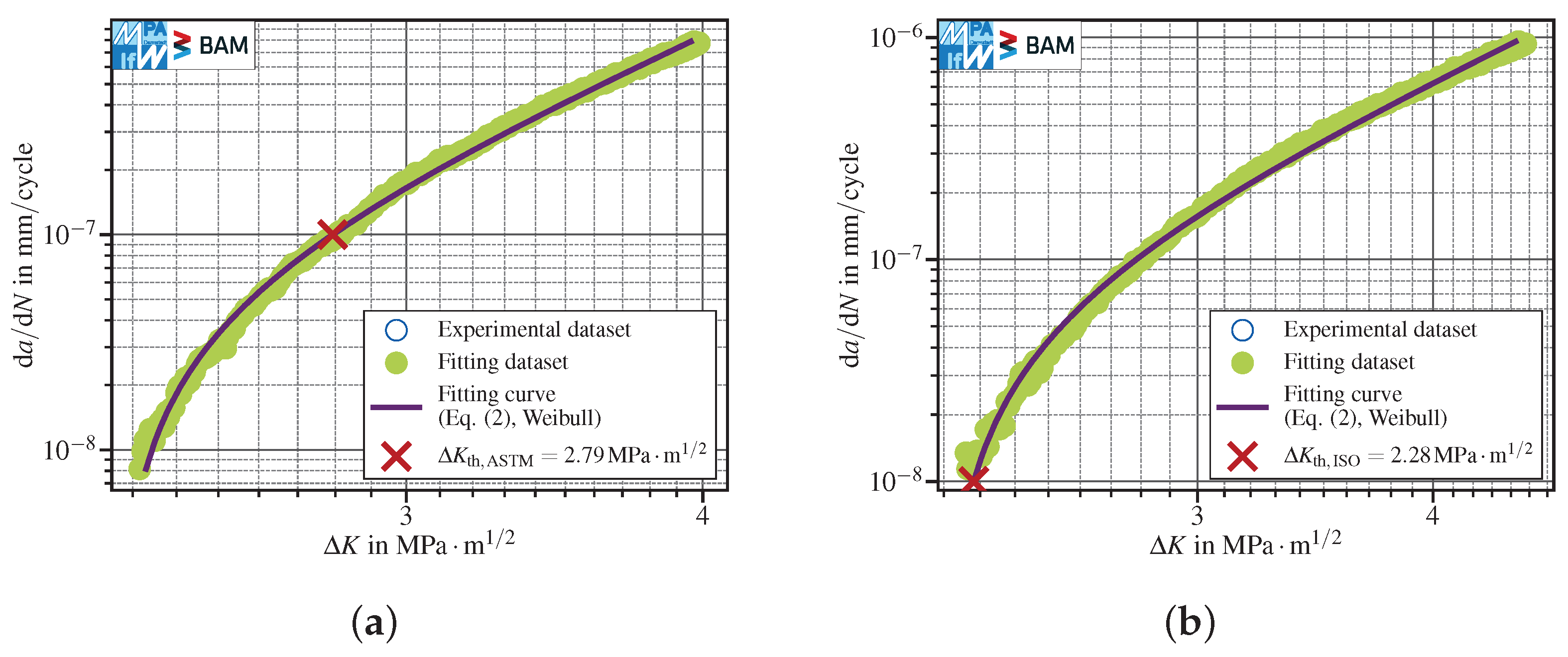
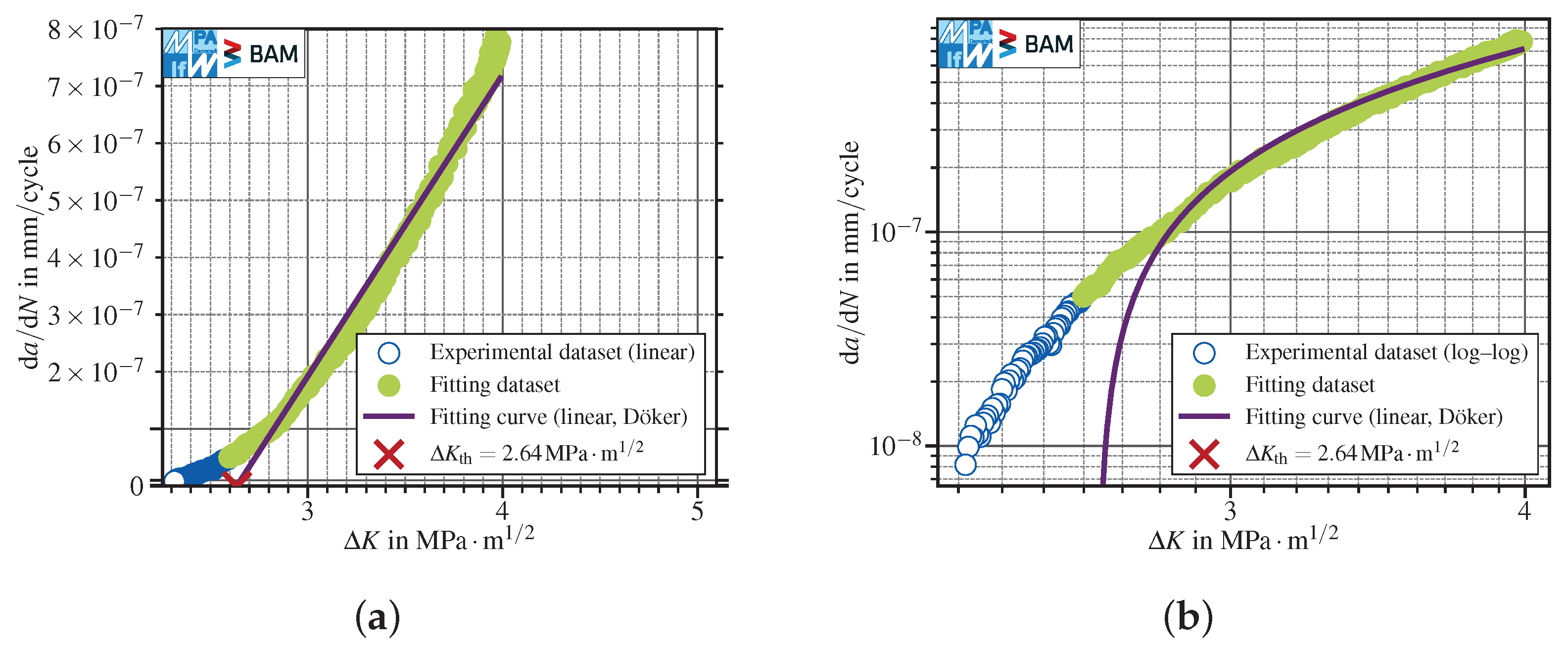


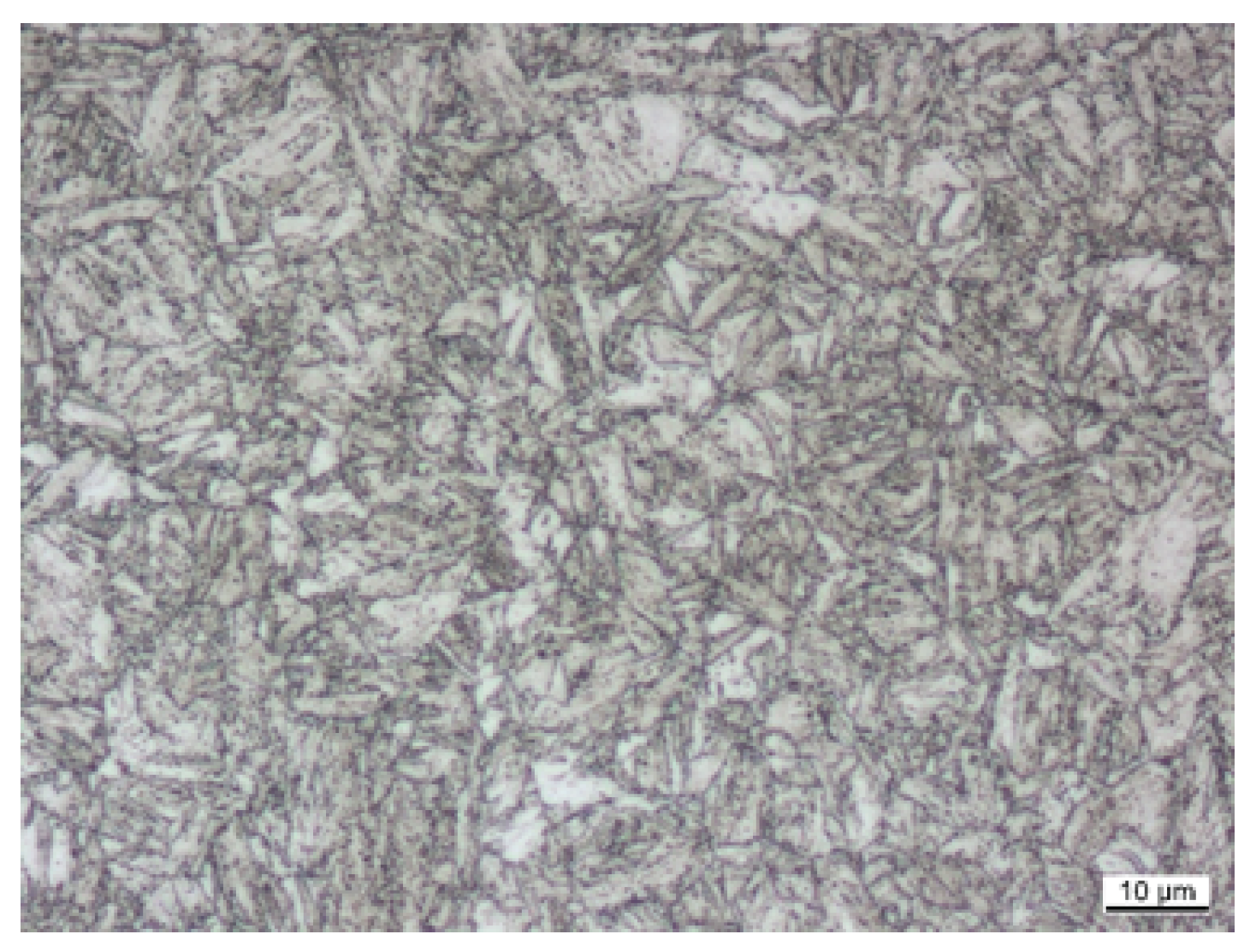

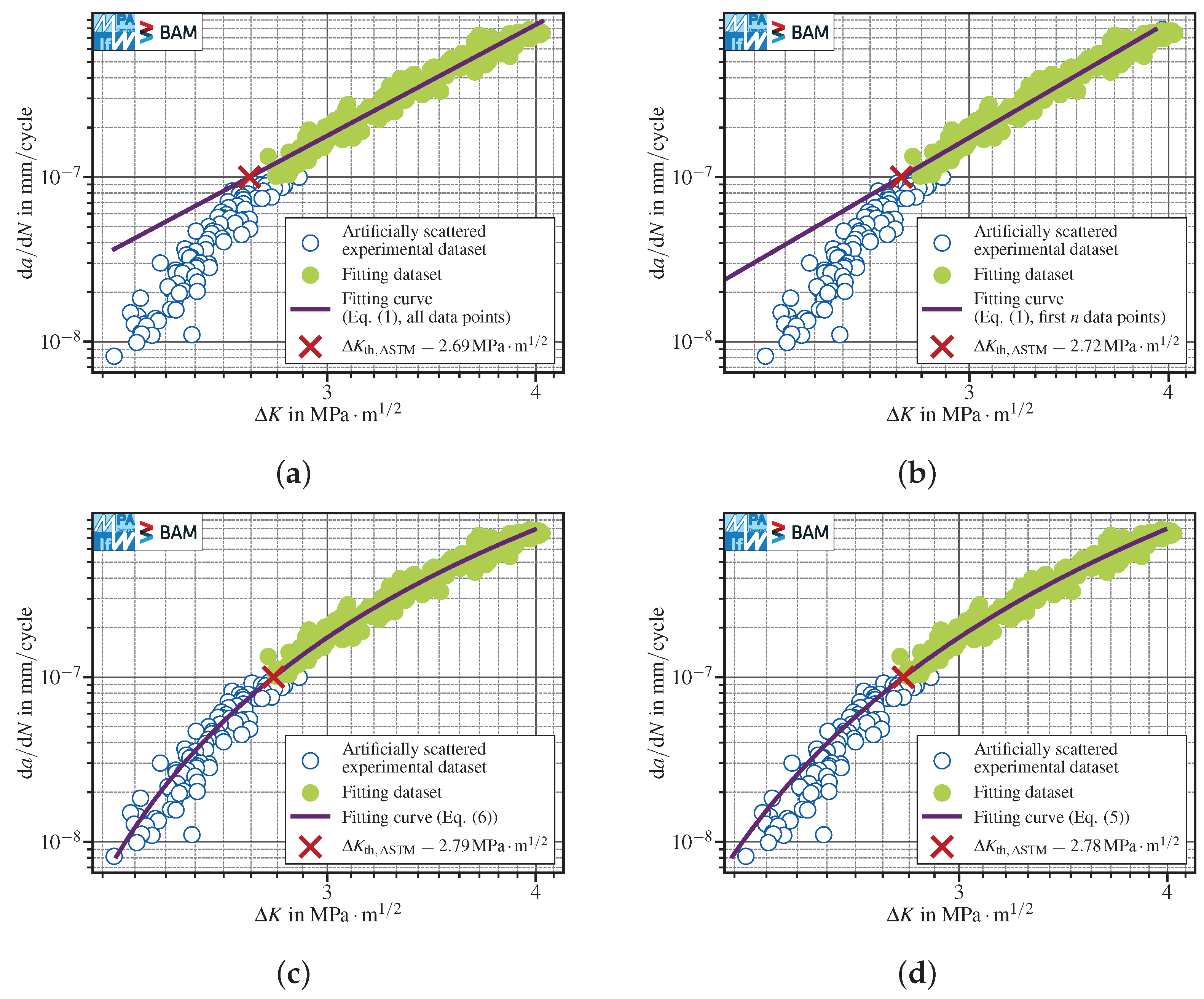
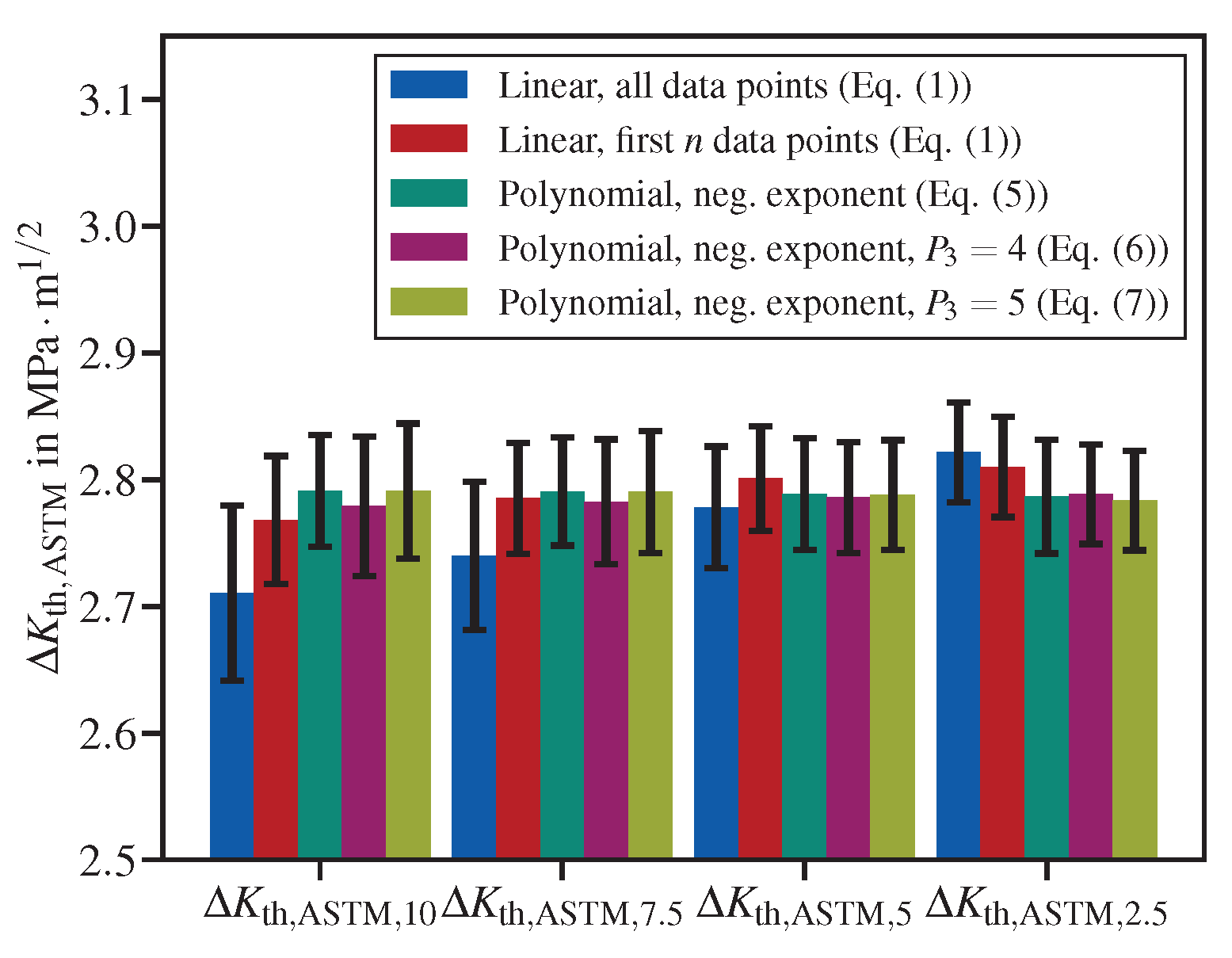
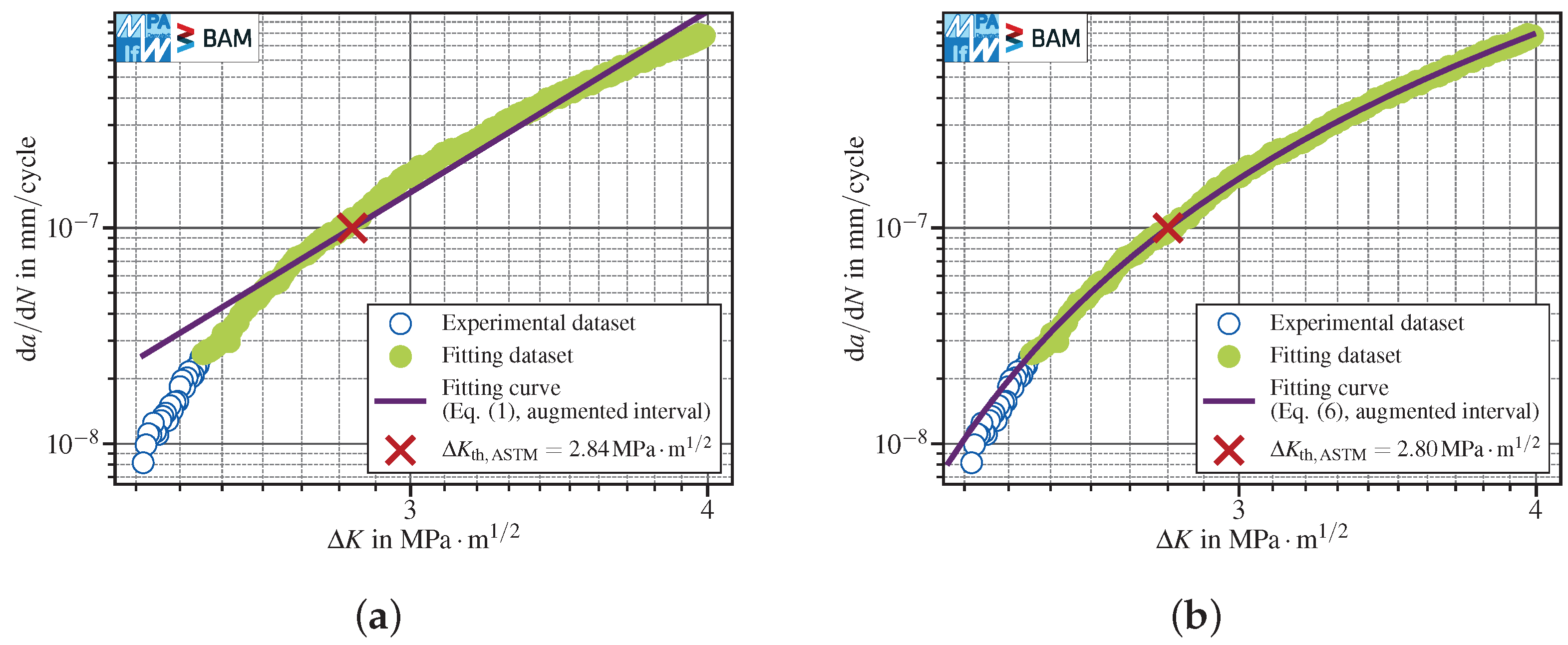
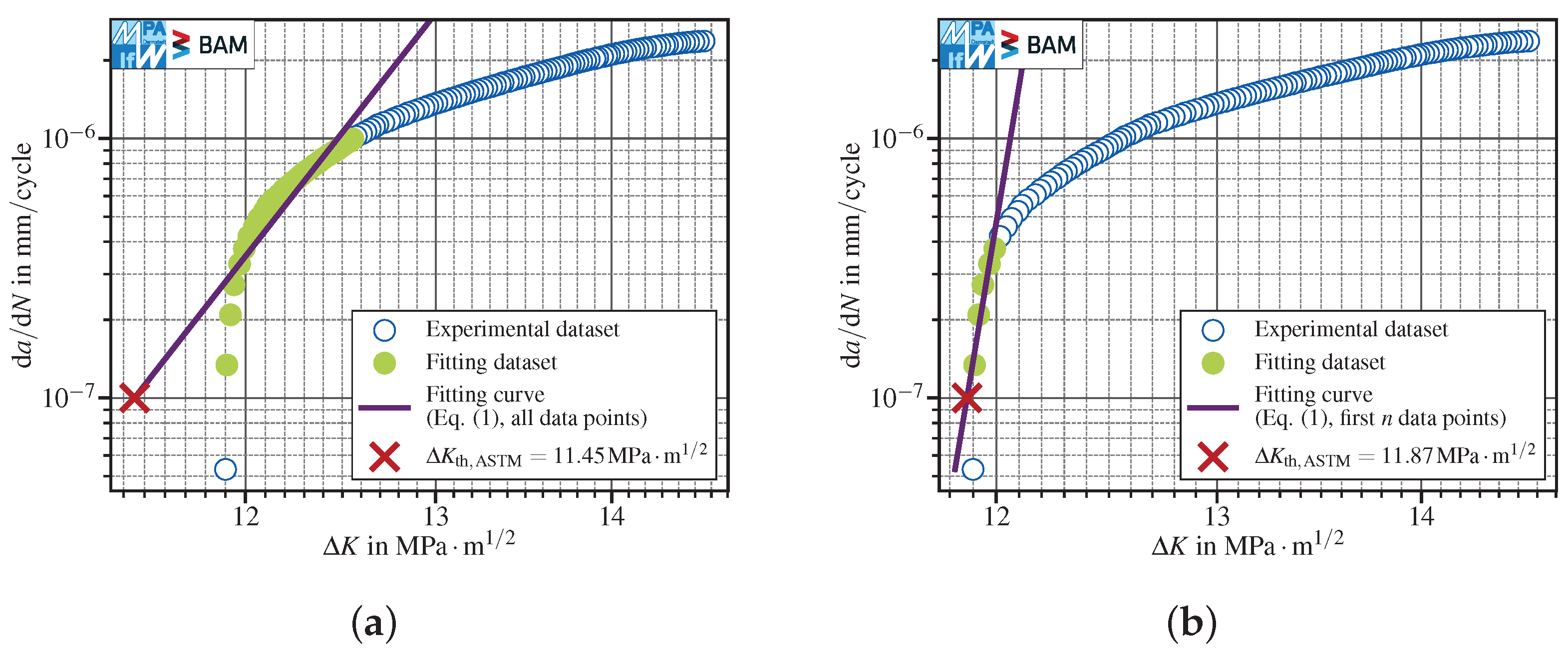
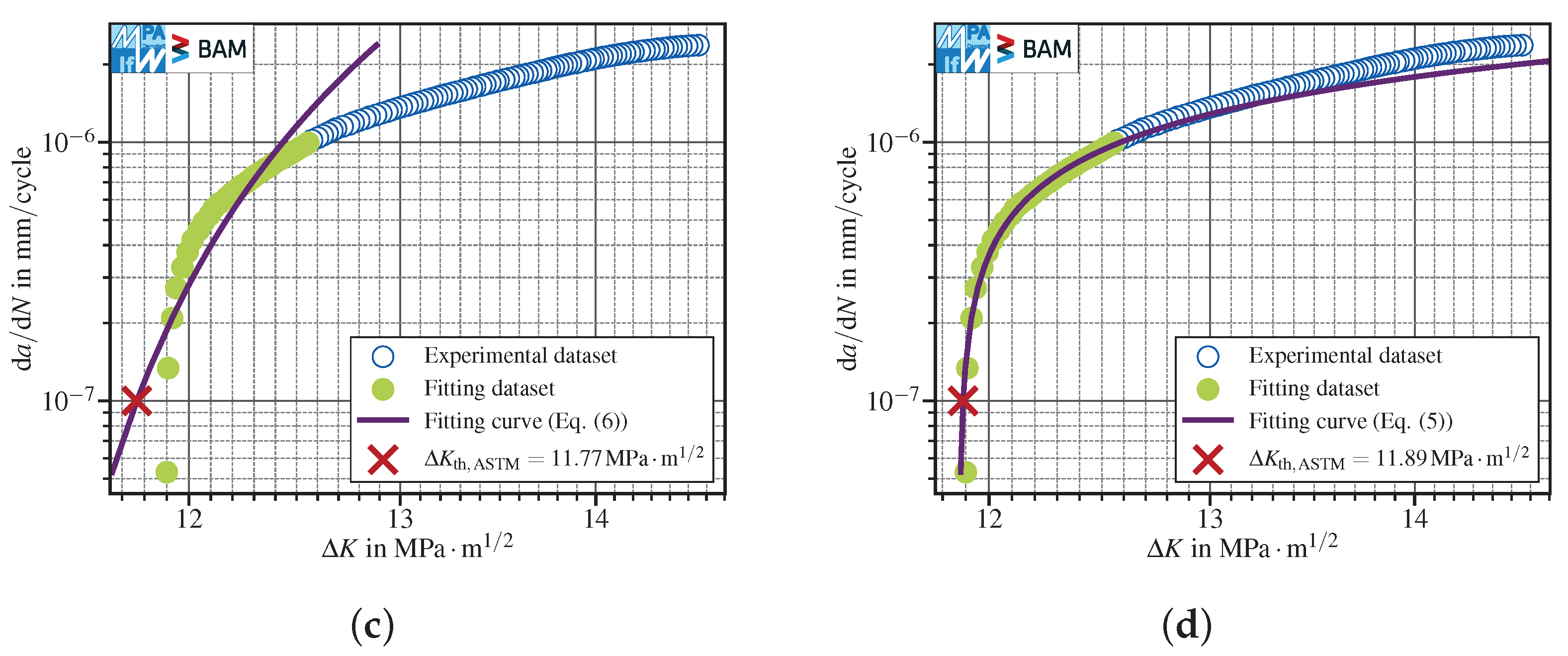
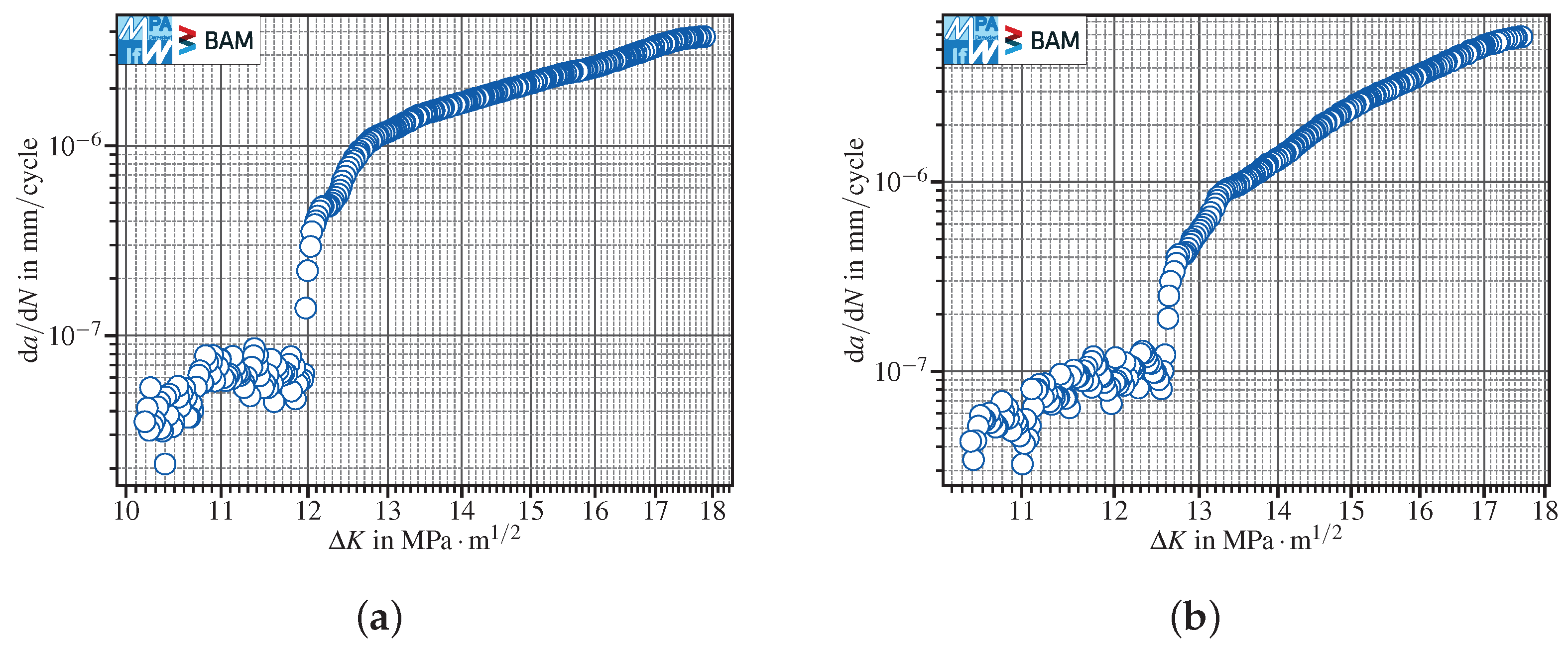

| C | Si | Mn | P | S | Cr | Mo | Ni | Al | Cu | Nb | Fe |
|---|---|---|---|---|---|---|---|---|---|---|---|
| in | in | E in | A in % | in (Orientation: T–L [20]) |
|---|---|---|---|---|
| 810 | 825 | 207 | 16 | 126 |
| Method | in | in |
|---|---|---|
| Linear, all data points (Equation (1)) | ||
| Linear, first n data points (Equation (1)) | ||
| Polynomial, neg. exp. (Equation (5)) | ||
| Polynomial, neg. exp. (Equation (6)) | ||
| Polynomial, neg. exp. (Equation (7)) |
| Method | in | in |
|---|---|---|
| Linear, all data points (Equation (1)) | ||
| Linear, first n data points (Equation (1)) | ||
| Polynomial, neg. exp. (Equation (5)) | ||
| Polynomial, neg. exp. (Equation (6)) | ||
| Polynomial, neg. exp. (Equation (7)) |
| Method | in | in |
|---|---|---|
| Linear, all data points (Equation (1)) | ||
| Linear, first n data points (Equation (1)) | ||
| Polynomial, neg. exp. (Equation (5)) | ||
| Polynomial, neg. exp. (Equation (6)) | ||
| Polynomial, neg. exp. (Equation (7)) |
| Method | in | in |
|---|---|---|
| Linear, all data points (Equation (1)) | ||
| Linear, first n data points (Equation (1)) | ||
| Polynomial, neg. exp. (Equation (5)) | ||
| Polynomial, neg. exp. (Equation (6)) | ||
| Polynomial, neg. exp. (Equation (7)) |
| Method | ||||
|---|---|---|---|---|
| Linear, all data points (Equation (1)) | 0.20 | −0.17 | 0.07 | −0.02 |
| Linear, first n data points (Equation (1)) | 0.23 | −0.18 | 0.07 | −0.02 |
| Polynomial, neg. exp. (Equation (5)) | 0.04 | −0.02 | 0.03 | −0.05 |
| Polynomial, neg. exp. (Equation (6)) | 0.03 | −0.01 | 0.03 | −0.00 |
| Polynomial, neg. exp. (Equation (7)) | 0.01 | −0.02 | 0.02 | −0.02 |
| Method | in | in |
|---|---|---|
| Linear, all data points (Equation (1)) | ||
| Linear, first n data points (Equation (1)) | ||
| Polynomial, neg. exp. (Equation (6)) |
| Method | in | in |
|---|---|---|
| Linear, all data points (Equation (1)) | ||
| Linear, first n data points (Equation (1)) | ||
| Polynomial, neg. exp. (Equation (6)) |
| Method | in | in |
|---|---|---|
| Linear, all data points (Equation (1)) | ||
| Linear, first n data points (Equation (1)) | ||
| Polynomial, neg. exp. (Equation (5)) | ||
| Polynomial, neg. exp. (Equation (6)) | ||
| Polynomial, neg. exp. (Equation (7)) |
| Method | in |
|---|---|
| Linear, all data points (Equation (1)) | |
| Linear, first n data points (Equation (1)) | |
| Polynomial, neg. exp. (Equation (5)) | |
| Polynomial, neg. exp. (Equation (6)) | |
| Polynomial, neg. exp. (Equation (7)) |
| Method | in | in |
|---|---|---|
| Linear, all data points (Equation (1)) | ||
| Linear, first n data points (Equation (1)) | ||
| Polynomial, neg. exp. (Equation (5)) |
Publisher’s Note: MDPI stays neutral with regard to jurisdictional claims in published maps and institutional affiliations. |
© 2022 by the authors. Licensee MDPI, Basel, Switzerland. This article is an open access article distributed under the terms and conditions of the Creative Commons Attribution (CC BY) license (https://creativecommons.org/licenses/by/4.0/).
Share and Cite
Schönherr, J.A.; Duarte, L.; Madia, M.; Zerbst, U.; Geilen, M.B.; Klein, M.; Oechsner, M. Robust Determination of Fatigue Crack Propagation Thresholds from Crack Growth Data. Materials 2022, 15, 4737. https://doi.org/10.3390/ma15144737
Schönherr JA, Duarte L, Madia M, Zerbst U, Geilen MB, Klein M, Oechsner M. Robust Determination of Fatigue Crack Propagation Thresholds from Crack Growth Data. Materials. 2022; 15(14):4737. https://doi.org/10.3390/ma15144737
Chicago/Turabian StyleSchönherr, Josef Arthur, Larissa Duarte, Mauro Madia, Uwe Zerbst, Max Benedikt Geilen, Marcus Klein, and Matthias Oechsner. 2022. "Robust Determination of Fatigue Crack Propagation Thresholds from Crack Growth Data" Materials 15, no. 14: 4737. https://doi.org/10.3390/ma15144737
APA StyleSchönherr, J. A., Duarte, L., Madia, M., Zerbst, U., Geilen, M. B., Klein, M., & Oechsner, M. (2022). Robust Determination of Fatigue Crack Propagation Thresholds from Crack Growth Data. Materials, 15(14), 4737. https://doi.org/10.3390/ma15144737







